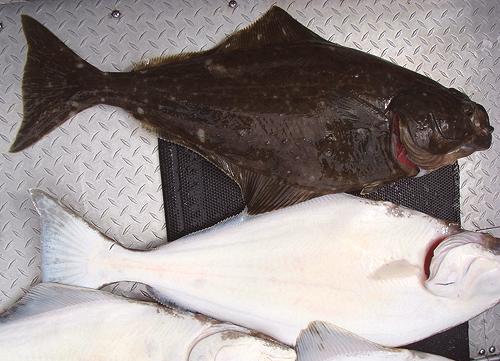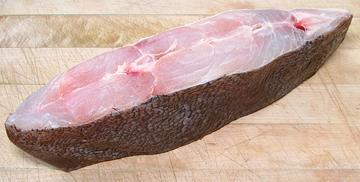Pacific Halibut
 [Hippoglossus stenolepis (Pacific) |
Hippoglossus hippoglossus (Atlantic)]
[Hippoglossus stenolepis (Pacific) |
Hippoglossus hippoglossus (Atlantic)]
Pacific Halibut are large righteye flounders growing to almost 9 feet
and 500 pounds. They are found from northern Baja California, Mexico
all they way around to the northern tip of Japan. They are a prized
eating fish and well known, so other flounder are sometimes labeled
"Halibut" in markets. I have seen Dover Sole labeled as "Baby Halibut"
but it is dark on both sides while Pacific Halibut is white on the blind
side.
This fish can be told from the smaller California Halibut from the
dorsal and anal fins being more pointy in the center, giving the body
a diamond shape. Pacific Halibut is not considered endangered, IUCN Red
List status NE (Not Evaluated), but the larger (to 710 pounds)
Atlantic Halibut is IUCN Red List rated "EN" (endangered) and
should not be fished or eaten.
Photo of Pacific Halibut by Jlikes2fish contributed to
the public domain.
More on Flounder Families.
 Pacific Halibut tends to be a rather large fish, so is most often
available as cross sectional steaks or part fillets. The photo specimen
was from a fish about 11 inches wide, not counting the fins. The steak
was from near the head end and cut at a fairly sharp diagonal to avoid
the body cavity at the bottom but get maximum meat from behind the head
at the top. The steak was 2-1/4 inches in cross section and 3-1/2 inches
along the length of the fish. This fish was probably around 36 inches
long, weighing somewhere around 25 pounds. Be aware that if one side of
a steak isn't white and the other dark, it's not Halibut.
Pacific Halibut tends to be a rather large fish, so is most often
available as cross sectional steaks or part fillets. The photo specimen
was from a fish about 11 inches wide, not counting the fins. The steak
was from near the head end and cut at a fairly sharp diagonal to avoid
the body cavity at the bottom but get maximum meat from behind the head
at the top. The steak was 2-1/4 inches in cross section and 3-1/2 inches
along the length of the fish. This fish was probably around 36 inches
long, weighing somewhere around 25 pounds. Be aware that if one side of
a steak isn't white and the other dark, it's not Halibut.
Pacific Halibut flesh is white, very mild, delicate in flavor and
texture, and flakes apart easily on the plate. It is an ideal fish
for those who like their fish "white and lite", and for fancy chefs
who don't want fish flavors interfering with their delicate sauces.
For these reasons it is considered a premium eating fish that fetches
a high price. For these very same reasons, I consider it very much
overpriced - I prefer my fish to taste like fish and have better
texture.
Cooking: This fish works best with dry cooking methods
such as frying, grilling or baking. Pieces of fillets can be poached if
they aren't too large and the poaching time is very short (4 minutes),
but it will be rather bland. You definitely don't want to try to use
this fish for soups or stews - it will just fall apart into individual
muscle fibers. My favorite way to eat this fish is lightly powdered
with rice flour and pan fried, skin-on, eaten with my simple
Lemon Wine Sauce.
Buying: The photo specimen was purchased from a
very large Asian market in Los Angeles (San Gabriel) for 2017 US $7.99
/ pound. This is pretty economical, since the yield is quite high, 83%
vs. less than 50% for most whole fish. It probably costs a lot more
from other sources.
Skin: The skin has very little shrink - so little
you can poach a skin-on piece and the skin will not distort it. It
quickly softens and almost disappears. Raw, it is thin but strong,
so can be removed with the usual long knife and cutting board
Method.
Cleaning, Filleting, etc: If you have acquired a
smaller fish whole, use the instructions for
California Halibut, as they
are nearly identical.
Subst: If size isn't a factor in a recipe there are
substitutes that have similar cooking properties. If you live on the
West Coast of the US, California
Halibut is the obvious choice, as it's fairly large, closely
related and almost identical in properties.
Petrale Sole can also be used,
but is quite a bit smaller. If you live on the US East Coast
Fluke (Summer Flounder or Southern
Flounder) should work, or in Western Europe you can use
Sole.
sf_pachalz 171108 - www.clovegarden.com
©Andrew Grygus - agryg@clovegaden.com - Photos on this
page not otherwise credited are © cg1 -
Linking to and non-commercial use of this page permitted
 Pacific Halibut tends to be a rather large fish, so is most often
available as cross sectional steaks or part fillets. The photo specimen
was from a fish about 11 inches wide, not counting the fins. The steak
was from near the head end and cut at a fairly sharp diagonal to avoid
the body cavity at the bottom but get maximum meat from behind the head
at the top. The steak was 2-1/4 inches in cross section and 3-1/2 inches
along the length of the fish. This fish was probably around 36 inches
long, weighing somewhere around 25 pounds. Be aware that if one side of
a steak isn't white and the other dark, it's not Halibut.
Pacific Halibut tends to be a rather large fish, so is most often
available as cross sectional steaks or part fillets. The photo specimen
was from a fish about 11 inches wide, not counting the fins. The steak
was from near the head end and cut at a fairly sharp diagonal to avoid
the body cavity at the bottom but get maximum meat from behind the head
at the top. The steak was 2-1/4 inches in cross section and 3-1/2 inches
along the length of the fish. This fish was probably around 36 inches
long, weighing somewhere around 25 pounds. Be aware that if one side of
a steak isn't white and the other dark, it's not Halibut. [Hippoglossus stenolepis (Pacific) |
Hippoglossus hippoglossus (Atlantic)]
[Hippoglossus stenolepis (Pacific) |
Hippoglossus hippoglossus (Atlantic)]